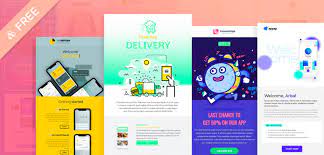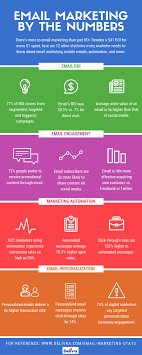Email Marketing Design: Creating Engaging and Effective Campaigns
In today’s digital era, email marketing remains one of the most powerful tools for businesses to connect with their audience. However, with inboxes flooded with countless messages every day, it’s crucial to create visually appealing and engaging email campaigns that stand out from the crowd. This is where email marketing design comes into play.
Designing an effective email campaign involves more than just selecting a template and adding some text. It requires careful consideration of various elements to ensure your message captures attention, drives engagement, and ultimately achieves your marketing goals. Here are some key factors to consider when it comes to email marketing design:
- Clear and Compelling Subject Line: The subject line is the first thing recipients see in their inbox. It should be concise, attention-grabbing, and relevant to encourage recipients to open your email.
- Responsive Design: With the majority of emails being opened on mobile devices, it’s essential to use responsive design techniques that adapt your email’s layout to different screen sizes. This ensures a seamless user experience across devices.
- Eye-Catching Visuals: Incorporating visually appealing elements such as high-quality images, graphics, or videos can significantly enhance the visual impact of your emails. Visuals should be relevant to your message and help convey your brand identity effectively.
- Consistent Branding: Your emails should reflect your brand identity consistently. Use consistent color schemes, fonts, and imagery that align with your overall branding strategy. This helps create a sense of familiarity and builds trust with your audience.
- Clear Call-to-Action (CTA): A well-designed CTA button or link is crucial for driving desired actions from recipients. Make sure it stands out prominently within the email and clearly communicates what action you want them to take.
- Personalization: Personalizing emails based on recipient data can significantly improve engagement rates. Incorporate dynamic content that addresses recipients by their name or tailors the message based on their preferences or previous interactions with your brand.
- Thoughtful Layout and Hierarchy: A well-organized layout with a clear hierarchy of information ensures that your message is easily scannable and digestible. Use headings, subheadings, and bullet points to break up text and guide readers through the email.
- A/B Testing: Experimentation is key to improving your email marketing campaigns. Conduct A/B tests to compare different design elements, such as subject lines, visuals, or CTAs, to determine what resonates best with your audience and drives higher conversions.
- Optimized Loading Speed: Slow-loading emails can discourage recipients from engaging with your content. Optimize image sizes and minimize code to ensure fast loading times across various email clients.
- Accessibility: Consider accessibility guidelines when designing your emails to ensure they are inclusive and can be easily accessed by individuals with disabilities. This includes using alt text for images and providing clear text alternatives for non-text content.
Remember, effective email marketing design is not just about aesthetics but also about delivering value to your audience. Craft compelling content that aligns with their needs and interests while leveraging design techniques to enhance engagement. By creating visually appealing and user-friendly email campaigns, you can drive better results, build stronger relationships with your audience, and ultimately achieve your marketing objectives.
7 Commonly Asked Questions About Email Marketing Design in English (UK)
- What is an email designer?
- What are the 3 styles of email?
- What is a email marketing design?
- How do you do email design?
- How do you write an email design?
- How do I design email marketing?
- How do you create email marketing?
What is an email designer?
An email designer is a professional who specializes in creating visually appealing and engaging email campaigns. They have expertise in designing emails that effectively convey a brand’s message, capture attention, and drive engagement.
Email designers possess a range of skills, including graphic design, HTML coding, and knowledge of email marketing best practices. They understand the importance of responsive design to ensure emails render well across different devices and platforms. They also consider factors such as branding consistency, clear call-to-action (CTA) placement, and layout hierarchy to optimize the user experience.
Email designers work closely with marketing teams or clients to understand their goals and target audience. They utilize their creative abilities to design eye-catching visuals, select appropriate color schemes, fonts, and imagery that align with the brand’s identity. They may also incorporate dynamic content or personalization techniques to enhance recipient engagement.
In addition to their design skills, email designers stay updated on industry trends and best practices. They are familiar with various email marketing platforms and tools that streamline the design process and provide analytics for measuring campaign performance.
Overall, an email designer plays a crucial role in creating effective email campaigns that stand out from the competition, build brand recognition, drive conversions, and ultimately contribute to the success of a business’s digital marketing efforts.
What are the 3 styles of email?
When it comes to email communication, there are three primary styles that can be used depending on the purpose and context of the message:
- Formal Email: Formal emails are typically used in professional or business settings. They follow a more structured and professional tone, adhering to proper grammar and etiquette. Formal emails are commonly used for important communications such as job applications, client correspondence, or official announcements. They often include a formal salutation and closing, and the language used is respectful and professional.
- Informal Email: Informal emails are more casual in nature and are commonly used for personal or friendly communication. They allow for a relaxed tone and often include informal language, abbreviations, or even emojis, depending on the relationship between the sender and recipient. Informal emails can be used to communicate with friends, family members, colleagues you have a close relationship with, or when discussing non-work-related matters.
- Semi-Formal Email: Semi-formal emails fall somewhere between formal and informal styles. These types of emails are often used in professional settings when you want to maintain a level of professionalism but also establish a friendly tone. Semi-formal emails may be appropriate when reaching out to colleagues you have a working relationship with but still want to maintain some level of formality.
It’s important to consider the context and purpose of your email before deciding which style to use. Adapting your writing style appropriately helps ensure effective communication while maintaining the desired level of professionalism or personal connection with your recipients.
What is a email marketing design?
Email marketing design refers to the process of creating visually appealing and engaging email campaigns. It involves strategically designing the layout, visuals, typography, and overall aesthetics of an email to effectively convey a marketing message and drive desired actions from recipients.
A well-designed email considers various elements such as subject lines, responsive design, visual content, branding consistency, clear call-to-action (CTA), personalization, thoughtful layout and hierarchy, A/B testing, optimized loading speed, and accessibility. These elements work together to capture attention, deliver a compelling message, and encourage recipients to take action.
The goal of email marketing design is to create emails that stand out in crowded inboxes, engage recipients visually and emotionally, and ultimately drive conversions or desired outcomes. By carefully considering design principles and incorporating effective strategies, businesses can enhance the effectiveness of their email marketing campaigns and build stronger connections with their audience.
How do you do email design?
Designing an email involves several steps to ensure it is visually appealing, engaging, and effective. Here’s a step-by-step guide on how to do email design:
- Define Your Goals: Before starting the design process, clearly define your goals and objectives for the email campaign. This will help you determine the overall message, call-to-action, and design elements needed to achieve those goals.
- Understand Your Audience: Consider your target audience’s preferences, interests, and demographics. Tailor your design to resonate with them and align with their expectations.
- Choose an Email Design Tool: Select a reliable email design tool or platform that offers customizable templates or allows you to create emails from scratch. Popular options include Mailchimp, Constant Contact, or Campaign Monitor.
- Select a Template or Layout: If using a template, choose one that suits your brand image and campaign goals. Ensure it is mobile-responsive and provides flexibility for customization.
- Branding Consistency: Incorporate your brand elements consistently throughout the email design. Use your logo, color scheme, fonts, and imagery that align with your overall branding strategy.
- Header Design: Create an eye-catching header that includes your logo or a compelling visual element related to the campaign theme or message.
- Clear Hierarchy: Organize information in a clear hierarchy using headings, subheadings, bullet points, or sections to guide readers through the content easily.
- Engaging Visuals: Incorporate relevant images, graphics, videos (if applicable), or infographics that support your message and capture attention. Ensure they are high-quality and optimized for fast loading times.
- Compelling Copywriting: Write concise yet persuasive copy that communicates your message effectively. Use compelling headlines and concise paragraphs to maintain reader interest.
- Call-to-Action (CTA): Place a prominent CTA button or link within the email design to drive recipients towards the desired action. Use contrasting colors and clear language to make it stand out.
- Responsive Design: Ensure your email design is responsive and adapts well to different screen sizes and devices. Test it on various email clients and mobile devices to ensure a seamless user experience.
- Test and Preview: Before sending out the email, thoroughly test and preview it across different email clients, browsers, and devices to ensure it renders correctly, images load properly, and links are working.
- Optimize for Accessibility: Consider accessibility guidelines by adding alt text for images, using readable fonts, providing sufficient color contrast, and ensuring keyboard navigation compatibility.
- A/B Testing: Conduct A/B tests by creating variations of your email design (e.g., subject lines, visuals, CTAs) to determine what resonates best with your audience. Analyze the results to optimize future campaigns.
- Review and Edit: Proofread the content for grammar, spelling errors, or formatting issues. Ensure that all links are correct and lead to the intended destination.
- Track Performance: After sending out the emails, analyze key metrics such as open rates, click-through rates (CTRs), conversions, or bounce rates. Use this data to refine future email designs and improve campaign effectiveness.
By following these steps and continuously refining your approach based on data-driven insights, you can create visually appealing emails that engage your audience effectively and drive desired actions.
How do you write an email design?
Writing an email design involves crafting the text content that accompanies the visual elements of your email campaign. Here are some key steps to follow when writing an email design:
- Define Your Objective: Clearly identify the purpose of your email and what action you want recipients to take. Whether it’s promoting a product, sharing news, or inviting them to an event, having a clear objective will guide your writing.
- Start with a Strong Opening: Grab the reader’s attention from the beginning with a compelling opening line or subject line that entices them to read further. Make it concise, engaging, and relevant to the content of your email.
- Personalize and Segment: Address recipients by their name to create a sense of personalization. If possible, segment your audience based on their interests or past interactions with your brand and tailor the content accordingly.
- Keep it Concise: Emails should be concise and easy to skim through. Use short paragraphs, bullet points, and subheadings to break up text and make it more scannable. Avoid lengthy blocks of text that may discourage readers from engaging.
- Highlight Key Information: Use headings or bold formatting to draw attention to important information such as offers, deadlines, or key points you want recipients to remember. This helps ensure that even skimmers get the main message.
- Maintain Brand Voice: Write in a tone that aligns with your brand personality and resonates with your target audience. Whether it’s formal, conversational, or playful, consistency in voice helps build familiarity and trust.
- Call-to-Action (CTA): Clearly state what action you want recipients to take and make it stand out within the email design using buttons or links. Use persuasive language that encourages immediate response.
- Provide Value: Focus on providing value to your readers rather than just promoting your own agenda. Offer useful tips, industry insights, exclusive offers, or relevant information that keeps them engaged and builds trust.
- Proofread and Edit: Before sending your email, proofread it carefully for grammar, spelling, and formatting errors. Ensure that all links are working correctly and that the content flows smoothly.
- Test and Optimize: Conduct A/B testing to compare different versions of your email design, including variations in subject lines, CTAs, or content structure. Analyze the results to identify what resonates best with your audience and refine your future campaigns.
Remember, the writing style should complement the visual elements of your email design to create a cohesive and impactful message. By combining effective writing techniques with visually appealing design elements, you can create engaging emails that drive action and deliver results.
How do I design email marketing?
Designing an effective email marketing campaign involves several steps. Here is a step-by-step guide to help you design your email marketing:
- Define your goals: Determine what you want to achieve with your email marketing campaign. Whether it’s promoting a product, driving traffic to your website, or nurturing customer relationships, having clear goals will shape the design and content of your emails.
- Understand your audience: Identify your target audience and understand their preferences, interests, and pain points. This knowledge will help you tailor your design and messaging to resonate with them effectively.
- Choose the right email marketing platform: Select a reliable email marketing platform that offers user-friendly design tools and automation features. Popular platforms include Mailchimp, Constant Contact, and Campaign Monitor.
- Select an email template: Most email marketing platforms provide pre-designed templates that you can customize to match your brand identity. Choose a template that aligns with your goals and suits the type of content you plan to send.
- Branding elements: Customize the template with your branding elements such as logo, color scheme, fonts, and imagery. Consistent branding helps reinforce brand recognition and trust among recipients.
- Layout and hierarchy: Design an organized layout with a clear hierarchy of information. Use headings, subheadings, bullet points, or columns to break up text and make it easy for recipients to scan through the email quickly.
- Compelling subject line: Craft a concise and attention-grabbing subject line that entices recipients to open the email. Experiment with different subject lines through A/B testing to determine what works best for your audience.
- Engaging content: Create compelling content that provides value to recipients. Use persuasive copywriting techniques combined with visuals such as images or videos relevant to the message you want to convey.
- Call-to-action (CTA): Include a clear CTA that prompts recipients to take action (e.g., “Shop Now,” “Learn More,” “Subscribe”). Make the CTA button or link stand out visually, and ensure its placement is easily noticeable within the email.
- Mobile-friendly design: Optimize your email design for mobile devices as a significant portion of recipients open emails on smartphones or tablets. Ensure your email template is responsive and adapts well to different screen sizes.
- Test and preview: Before sending out your campaign, test your email across various email clients and devices to ensure it displays correctly. Most email marketing platforms offer preview options to help you see how your email will appear to recipients.
- Personalization and segmentation: Leverage personalization techniques by addressing recipients by their name or tailoring content based on their preferences or previous interactions with your brand. Segment your audience to send targeted emails that resonate with specific groups.
- Monitor and analyze: Once you’ve sent out your emails, monitor key metrics such as open rates, click-through rates, and conversions. Analyze this data to gain insights into what works best for your audience and make improvements for future campaigns.
Remember, effective email marketing design goes beyond aesthetics—it’s about delivering value, building relationships, and driving desired actions from your audience. Continuously refine your design strategy based on feedback and data analysis to optimize results over time.
How do you create email marketing?
Creating an effective email marketing campaign involves several steps. Here’s a general guide on how to create an email marketing campaign:
- Define your goals: Determine what you want to achieve with your email campaign. Whether it’s promoting a new product, driving website traffic, or nurturing leads, having clear goals will shape your strategy.
- Identify your target audience: Understand who your target audience is and segment your email list accordingly. Segmenting allows you to send more personalized and relevant content to different groups of subscribers.
- Choose an email marketing platform: Select a reliable email marketing platform that suits your needs. Popular options include Mailchimp, Constant Contact, and SendinBlue. These platforms offer features like template design, automation, analytics, and list management.
- Design your email template: Create an eye-catching and responsive email template that aligns with your brand identity. Consider using pre-designed templates provided by the chosen platform or customize them according to your requirements.
- Craft compelling content: Write engaging and concise copy for your emails. Grab the reader’s attention with an attention-grabbing subject line, provide valuable information or offers in the body of the email, and include a clear call-to-action (CTA) that prompts recipients to take action.
- Personalize the emails: Use personalization tokens to address recipients by their name or leverage dynamic content based on their preferences or past interactions with your brand. Personalization helps establish a connection and increases engagement.
- Test and optimize: Before sending out the campaign, thoroughly test it across different devices and email clients to ensure proper rendering and functionality. Test various elements like subject lines, CTAs, visuals, and layouts through A/B testing to optimize performance.
- Schedule and send: Choose an optimal time for sending the emails based on industry research or past data analysis of your audience’s behavior. Schedule the campaign accordingly using the features provided by the email marketing platform.
- Monitor and analyze: Track the performance of your email campaign using the analytics provided by your email marketing platform. Monitor metrics such as open rates, click-through rates, conversions, and unsubscribe rates to gauge the effectiveness of your campaign.
- Iterate and improve: Based on the insights gained from analytics, make improvements to future campaigns. Continuously iterate on your email marketing strategy by refining content, design elements, targeting strategies, and timing to achieve better results.
Remember that building a successful email marketing campaign takes time and experimentation. Regularly evaluate and refine your approach to better connect with your audience and achieve your goals.




